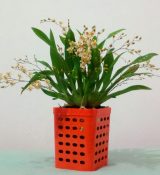Orchids In The Garden
Author: adminNo Comments
Blooming, Care and Culture, Growing Outdoors
Some very attractive terrestrial genera from the northern temperate areas of the world are completely deciduous during the cold weather.
They do not begin their annual cycle of growth until temperatures begin to rise in the spring and they flower during late spring or mid-summer, set seeds during the later summer and autumn, and die down again before the first frosts of winter. The genera include some of the species of the genus, Cypripedium (Lady’s Slipper), and also a number of species of Dactylorhiza, both of which can make a spectacular addition to the woodland border and drier regions of the bog garden.
The North American Epipactis gigantea is an irrepressible and beautiful ornament to any damp, slightly acidic situation, forming large clumps especially beside streams. All these orchids require a humus-rich, moisture-retentive soil, which should not become waterlogged or be allowed to dry out completely. Any good garden loam can be made suitable by the incorporation of peat and decaying leaves into the top 12in (30cm) of soil. The dormant rhizomes or tuberous roots can be planted in this mixture. Dappled shade, or a position which is sunny for only part of the day, is suitable for several of the species. A few species prefer calcareous soils, including the European Cypripedium calceolus, and a suitable niche for this species can be prepared by adding small pieces of chalk or limestone to the prepared site.
Some of the orchids which normally grow in grassland habitats, including species of Orchis or Ophrys, grow well in lawns in various parts of England. The only special care required is that they should not be grown early in the year, before or immediately after flowering. The plants should also be established while the tubers are dormant, and, because they come into growth rather earlier than the woodland species, it is probably best to introduce the tubers during the autumn. Each should be set in a small cavity lined with sharp sand, at least 2in (5cm) below the surface of the ground.


Ask an Expert
Questions about orchids?
Our experts love a challenge!
Photo of the Week
Submit your photo to be featured on the blog!
More Photo of the Week Winners
Submit Photo







